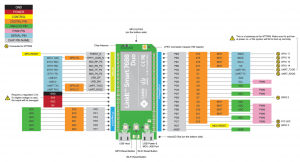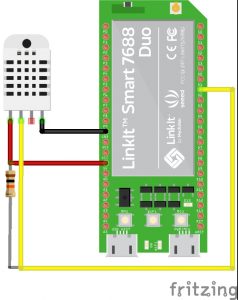The Yún has two processors on board. One is an ATmega32U4 like on the Arduino Leonardo (we call it MCU from now on). The other is an Atheros 9331 (we call it MPU from now on), running Linux and the OpenWRT wireless stack, which enables the board to connect to WiFi and Ethernet networks. This tutorial also works for the linkit 7688 Duo. To run it on a linkit, please enable the arduino yun bridge software. You can find it in my older posts.
The bridge has quite some options available, for me there are two use case who are practical for me:
1.) Sending sensor data from the MCU to a server
2.) Bi-directional communication between a server and the MCU
Sending sensor data from the MCU to a server
Say for example that you have a sensor which can measure the temperature and partical concentration and you want to upload it to a restfull api webserver. In this case you are only sending data from the MCU to a server. Easiest solution is to use the “runShellCommand”. As the functionname tells us, it runs a command in the shell.
There are two flavours, runShellCommandAsynchronously() and runShellCommand(). runShellCommand() is a blocking function. That is, once you call Process.runShellCommand(), nothing else will happen in your sketch until it has completed. The time depends on the nature of the command you are executing. For a non-blocking alternative, please use runShellCommandAsynchronously().
Now we have a solution to run from your sketch a shell command. Now we have access to the shell, we need a tool to upload our data to the server. We can use Curl for this. Curl is an open source command line tool and library for transferring data with URL syntax. Eg. you can download a webpage, or upload via json data to a restfull api.
#include <Process.h>
void setup(void) {
Bridge.begin();
}
void loop(void) {
String curlCmd;
String resultConcentration;
String resultTemperature;
resultConcentration=5.5;
resultTemperature=20.0;
curlCmd = "curl -H \"Content-Type: application/json\" -X POST -d \'{\"concentration\": "+resultConcentration+", \"temperature\": "+resultTemperature+"}\' http://192.168.x.xx:8080/measurement";
Process database;
database.runShellCommand(curlCmd);
delay(1000);
}
You need to include for the bridge communication. “Bridge.begin()” starts Bridge, facilitating communication between the MCU and MPU. This should be called once in setup(). begin() is a blocking function. Once you call Bridge.begin(), nothing else will happen in your sketch until it has completed. This process takes approximately three seconds.
Process is the base class for all Bridge based calls for communicating with the Yun’s shell. Followed by run() or runAsynchronously(). The named process does not start executing until run() is called.
Bi-directional communication between a server and the MCU
For bi-directional communication you need to have a program/script running on the MPU. This will have a connection to a server (Eg. MQTT broler) and read/writes to the bridge. On the MCU you will need to have a sketch which can read/write to the bridge.
Sketch
The put() function allows you to store data on the MPU using a Key/Value structure. The Key field is like a label and you can associate a value to it. The key name must be unique in order to identify the correct value. On the MPU side there is a data store where all the keys and the values are saved.
The datastore is saved in the RAM of the MPU (AR9331), you will lose the datastore when you restart the bridge software on the Linux side (through power cycling, resetting the Linux processor, or uploading a sketch through WiFi or Ethernet). You will not lose the datastore if you reset the MCU (ATMega32u4 processor).
get() allows you to read a key/value item previously saved on the MPU. You can request for a value stored in the datastore by passing get() the Key you want to search for, the support buffer, and its size. The Key is similar to a label, used to identify an associated value. The key name must be unique in order to identify the correct value.
#include <Bridge.h>
unsigned long timer;
unsigned long counter = 0L;
void setup()
{
Bridge.begin(); // this launches /usr/bin/run-bride on Linino
timer = millis();
Serial.begin(9600);
}
void loop()
{
/* Every 200ms: */
char bridge_Value[6];
if (millis() - timer > 200) {
timer = millis();
Bridge.put("counter", String(counter++));
Bridge.put("random1", String(random(1, 100)));
Serial.println(counter);
Bridge.get("hello", bridge_Value, 6);
Serial.println(bridge_Value);
}
}
Python script
For the MPU I’ve chosen to use a python script. You need to import the bridge library. The code is rather self explaining. You can also access the data via the API of the arduino Yun. In our case you can use http://192.168.x.xx/data/get/counter to read the value of counter, or write to counter via http://192.168.x.xx/data/put/counter/4
#!/usr/bin/python
import time
import sys
sys.path.insert(0, '/usr/lib/python2.7/bridge/')
from bridgeclient import BridgeClient as bridgeclient
value = bridgeclient()
while True:
message = value.get("counter")
print message
value.put('hello','world')
time.sleep(1)
value.put('hello','you')
The sketch code is based on code from Jan-Piet Mens. The python from alnitak1000. I combined both the bridge.put()/bridge.get() and value.put()/value.get() together.

